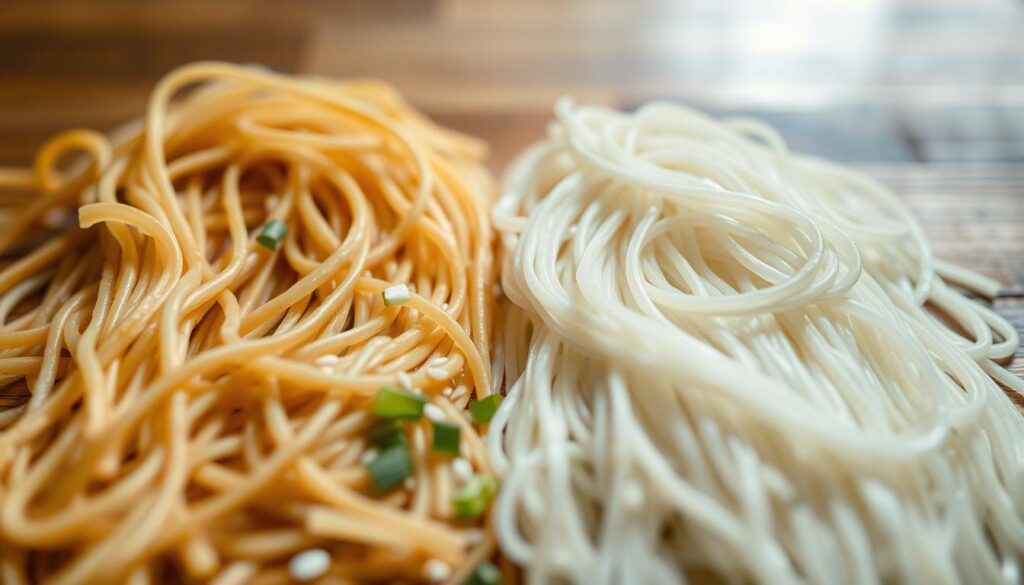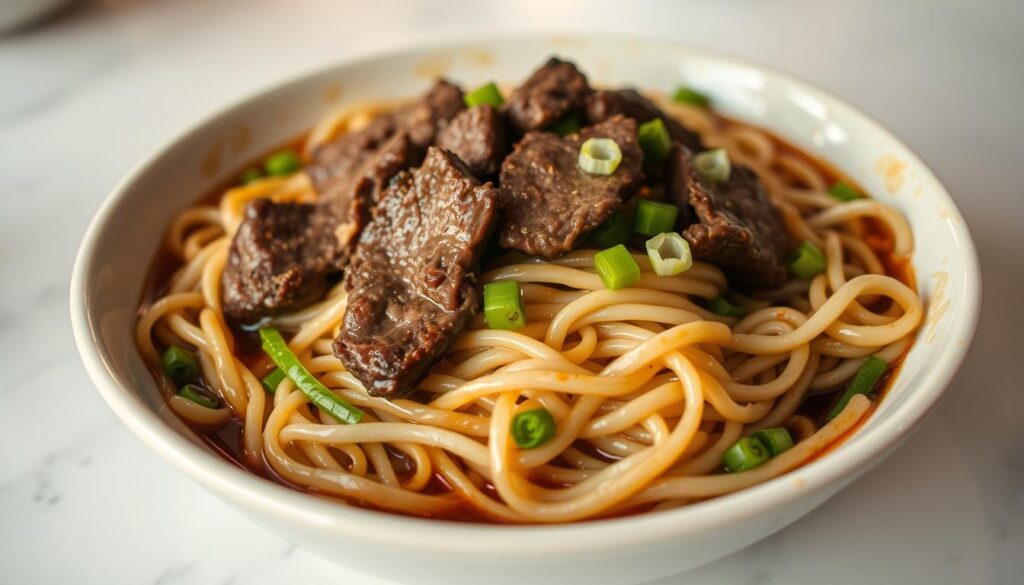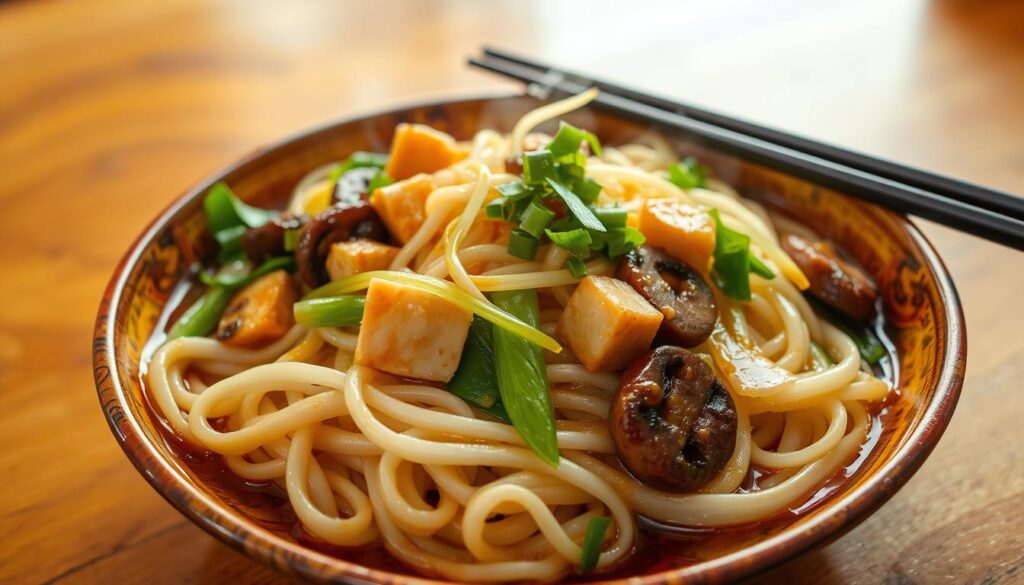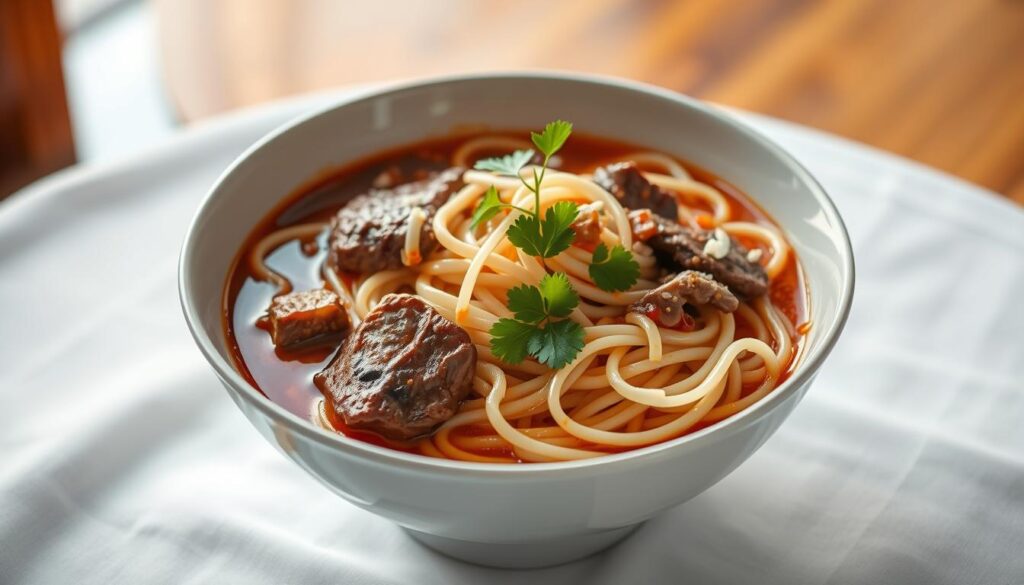Hor Fun, a dish with deep Chinese roots, has become a staple in local food culture. Known for its smooth rice noodles and rich flavors, it’s a go-to comfort food for many. This signature dish is widely available at hawker stalls and zi char eateries across the island.
There are several popular variations, including moonlight, Ipoh, and san lau styles. Each version offers a unique taste, often paired with seafood or beef. Whether you’re a local or a visitor, this dish is a must-try for its cultural and culinary significance.
In this article, we’ll guide you through over 20 top-rated spots to enjoy this beloved dish. From Michelin-recognized eateries to hidden gems, there’s something for everyone. Stay tuned to discover where to find the most flavorful plates of this iconic food.
Key Takeaways
- Hor Fun is a popular dish with Chinese origins, loved for its smooth rice noodles.
- It’s a staple at hawker stalls and zi char eateries across the island.
- Popular variations include moonlight, Ipoh, and san lau styles.
- Often paired with seafood or beef for a rich and satisfying taste.
- Discover over 20 top-rated spots to enjoy this iconic dish.
Introduction: Singapore’s Love Affair with Hor Fun
Hor Fun has evolved from a luxury dish in the 1960s to a beloved comfort food today. Its smooth rice noodles and rich flavors make it a go-to choice for many. Whether enjoyed at hawker centers or upscale eateries, this dish holds a special place in local food culture.
Why Hor Fun Is a Local Favorite
What makes Hor Fun so popular? It’s the perfect blend of texture and flavors. The silky noodles absorb the savory gravy, while the edges caramelize for a crispy finish. This contrast creates a satisfying bite that keeps people coming back for more.
Another reason for its popularity is its affordability. Prices range from $3 to $20, making it accessible to everyone. From humble hawker stalls to Michelin-recognized spots like Shi Hui Yuan and KEK Keng Eng Kee, there’s a version for every budget.
“Hor Fun is more than just a dish; it’s a shared experience that brings families together.”
The Art of Wok Hei in Hor Fun
The secret to great Hor Fun lies in the wok hei technique. This method involves cooking in a carbon steel wok at temperatures exceeding 1,200°F. The high heat infuses the dish with a smoky aroma and enhances its flavors.
At KEK Keng Eng Kee, this technique has earned them Michelin Plate awards from 2016 to 2021. Their mastery of wok hei sets a benchmark for quality in this iconic dish.
| Feature | Description |
|---|---|
| Texture | Silky noodles with crispy edges |
| Flavors | Rich, savory gravy with smoky aroma |
| Price Range | $3 – $20 |
| Key Technique | Wok hei (high-heat cooking) |
For more insights into the history of this dish, check out this detailed look back at its evolution.
A Brief History of Hor Fun in Singapore
The story of Hor Fun in Singapore is a journey of tradition and innovation. This iconic dish, with its smooth rice noodles and rich flavors, has deep roots in Chinese culinary heritage. Its evolution reflects the island’s vibrant food culture.
From Street Food to Hawker Staple
Hor Fun’s origins trace back to the 1950s, when Teochew pushcart vendors introduced it as a hand-cut noodle dish. These vendors would serve it fresh, often with a savory broth or gravy. Over time, it became a staple at hawker centers, loved for its affordability and comforting taste.
Post-war migration played a key role in shaping the dish. As people from different regions settled in Singapore, they brought their unique styles and ingredients. This led to the standardization of Hor Fun as a hawker favorite.
Regional Variations: Cantonese vs. Malaysian Styles
Hor Fun’s regional variations add to its charm. The Cantonese style features a dark soy-based gravy, rich and full of flavor. In contrast, Malaysian versions, like the Ipoh style, use mineral water from Ipoh to create softer, silkier noodles.
Modern innovations have also left their mark. Some eateries now add sous-vide eggs, blending tradition with contemporary techniques. Yet, places like Hong Sheng Restaurant continue to uphold traditional methods, ensuring the dish’s authenticity.
“Hor Fun is a testament to Singapore’s ability to blend tradition with innovation.”
| Style | Key Features |
|---|---|
| Cantonese | Dark soy-based gravy, rich flavors |
| Malaysian (Ipoh) | Mineral water noodles, softer texture |
| Modern | Innovations like sous-vide eggs |
| Traditional | Enduring methods at 30-year-old eateries |
Where to Find the Best Hor Fun in Singapore
Discovering the top spots for this iconic dish is a culinary adventure. From bustling hawker centers to cozy eateries, each location offers a unique take on this beloved meal. Here are some standout places to try.
Ipoh Lee Tuck Kee Son: A Chain Worth Trying
Ipoh Lee Tuck Kee Son is a must-visit for fans of this dish. Known for their individual wok frying technique, they ensure every plate is fresh and flavorful. Their signature raw egg yolk topping adds a creamy richness to the silky noodles.
Be prepared for a wait—popularity often leads to 1-hour queues. But the quality and taste make it worth every minute.
Yalong Bay: Hidden Gem in Toa Payoh
Yalong Bay offers a unique twist with their crispy la-la clams. Priced at $17, this version is a treat for seafood lovers. The air-conditioned comfort adds to the dining experience, making it a perfect spot for a relaxed meal.
Hong Lim Food Centre’s Hidden Treasures
At Hong Lim Food Centre, Tang Kay Kee stands out with its innovative toppings. Their sous-vide egg and enoki mushrooms elevate the dish to a new level. It’s a favorite among locals for its creativity and bold flavors.
Alexandra Village’s Legendary Version
Alexandra Village Food Centre is home to a budget-friendly yet premium version. At just $5, their beef dish comes with a silky egg sauce that’s rich and satisfying. It’s a great option for those looking for quality without breaking the bank.
For more insights into the history of this dish, check out this detailed look back at its evolution.
Kway Teow vs. Flat Rice Noodles: What’s the Difference?
When it comes to rice noodles, the distinction between Kway Teow and flat rice noodles often sparks curiosity. Both are staples in Southeast Asian cuisine, but their unique characteristics set them apart. Understanding these differences can elevate your appreciation for these beloved dishes.

Hor Fun, known for its wider and silkier noodles, is perfect for absorbing rich gravies. Its 2cm width allows it to cling to sauces, creating a flavorful bite. On the other hand, Kway Teow, with its thinner 1cm width, offers a chewier texture ideal for stir-fries.
Popular Dishes Featuring Both
Each noodle type shines in specific preparations. Hor Fun excels in dishes like Jin Hock’s Double Flavored Hor Fun, where its silky texture pairs beautifully with savory gravies. Kway Teow, meanwhile, is a star in char kway teow, a dry-tossed stir-fry that highlights its chewiness.
Regional naming conventions also play a role. In Malaysia, Kway Teow is often referred to as “flat rice noodles,” while in Singapore, it’s commonly called “Hor Fun.” This linguistic diversity reflects the dish’s widespread popularity across Southeast Asia.
For home chefs, the cooking method matters. Hor Fun thrives in dishes with ample sauce, while Kway Teow is best suited for high-heat stir-frying. Mastering these techniques ensures each noodle type reaches its full potential.
What Makes Great Hor Fun?
The art of crafting the perfect plate of this iconic dish lies in mastering a few key elements. From the smoky aroma of wok hei to the freshness of the ingredients, every detail matters. Let’s explore what sets apart a truly exceptional version of this beloved meal.
Wok Hei: The Secret to Perfect Hor Fun
The wok hei technique is the backbone of this dish. Cooking at temperatures exceeding 15,000 BTUs, chefs infuse the noodles with a smoky aroma and caramelized edges. This high-heat method ensures the flavors are rich and the texture is perfectly balanced.
At KEK Keng Eng Kee, the use of pork lard and lup cheong enhances the dish’s depth. Their mastery of wok hei has earned them consistent acclaim, making it a benchmark for quality.
Fresh Ingredients Matter
Quality ingredients are non-negotiable. Coastal stalls prioritize daily catches of fresh seafood, ensuring every bite is flavorful. Shi Hui Yuan takes it a step further with a collagen-rich gravy made from over 30 herbs, adding both taste and health benefits.
Marinating beef for at least 30 minutes and properly preparing prawns also contribute to the dish’s excellence. Freshness elevates the overall experience, making it unforgettable.
Balancing Sauce and Noodle Texture
The harmony between sauce and texture is crucial. A cornstarch-to-broth ratio of 1:3 creates the ideal viscosity, allowing the gravy to cling to the noodles without overpowering them. Heng Heng’s strategy of using pre-cooked noodles ensures consistency, while others prefer fresh noodles for a silkier feel.
This balance ensures every bite is a blend of smooth noodles and rich, savory flavors.
| Element | Key Detail |
|---|---|
| Wok Hei | High-heat cooking at 15,000+ BTUs |
| Ingredients | Fresh seafood, collagen-rich gravy |
| Sauce Texture | Cornstarch-to-broth ratio of 1:3 |
| Noodle Preparation | Pre-cooked vs. fresh noodles |
Best Beef Hor Fun in Singapore
Beef lovers rejoice—this dish offers tender slices paired with rich, savory gravy. The combination of silky rice noodles and perfectly cooked meat creates a satisfying meal. Whether you prefer it with black bean sauce or a peppery kick, there’s a version for every palate.

The Art of Tender Beef
The secret to tender beef lies in the slicing technique. Cutting against the grain ensures each piece is soft and easy to chew. At Hin Fried, their pink-centered beef slices are a testament to this method. The result is a melt-in-your-mouth experience that complements the silky noodles.
Marination also plays a key role. Alexandra Village’s 24-hour marinated beef adds depth of flavor, while the collagen-rich gravy enhances the dish’s richness. These details make every bite unforgettable.
Top Spots for Beef Lovers
For a unique twist, try Bee Kia’s black bean sauce version near Thomson Medical. The bold flavors of the sauce pair perfectly with the tender beef. Another standout is Ipoh Lee Tuck Kee Son, where the wat tan egg ribbon adds a creamy richness to the dish.
Whether you’re a fan of pepper-heavy profiles or prefer the umami of black bean sauce, these spots deliver exceptional quality. Each location offers a unique take on this beloved dish, making it a must-try for beef enthusiasts.
Seafood Hor Fun Delights
Seafood lovers will find a treasure trove of flavors in this dish, combining the ocean’s bounty with silky rice noodles. From succulent prawns to briny clams, each bite offers a taste of the sea. This variation is a favorite for its rich textures and fresh ingredients.
Prawns, Clams, and Ocean Freshness
At Holland Village XO Fish Head, the de-veined prawns are a standout feature. Their freshness ensures a sweet, juicy bite that pairs perfectly with the silky noodles. Golden Charcoal Seafood takes it further with their briny lala clams, adding a unique depth of flavor.
Proper cleaning techniques are essential to avoid grit in shellfish. Coastal stalls often source their seafood from morning markets, ensuring every plate is made with the freshest catch. This attention to detail elevates the dish to new heights.
Coastal Eateries with the Best Catch
Jin Hock’s dual-texture version is a must-try. Their innovative approach combines crispy and silky noodles, creating a delightful contrast. Yalong Bay’s crispy tofu pairing adds a creative twist, making it a hit among diners.
East and West coast flavor profiles also differ. The East coast offers a lighter, more delicate taste, while the West coast leans toward bolder, richer flavors. This regional diversity ensures there’s something for every palate.
“The freshness of the seafood makes all the difference. It’s what turns a good dish into an unforgettable one.”
| Feature | Description |
|---|---|
| Prawns | De-veined, sweet, and juicy |
| Clams | Briny, fresh, and flavorful |
| Preparation | Proper cleaning to avoid grit |
| Regional Flavors | East coast: light; West coast: bold |
Vegetarian and Vegan Hor Fun Options
For those seeking plant-based alternatives, this iconic dish offers a variety of flavorful options. From mushroom-based gravies to tofu toppings, these versions are just as satisfying as their traditional counterparts. Whether you’re vegetarian or vegan, there’s a plate of this beloved meal waiting for you.

Mushroom-Based Gravy and Tofu Toppings
Mushroom-based gravies are a popular choice for plant-based versions of this dish. Shiitake and porcini mushrooms add depth and umami to the sauce, creating a rich and savory base. Tofu ribbons often replace eggs, offering a similar texture while keeping the meal vegan-friendly.
Bean sprouts and other fresh ingredients enhance the dish’s crunch and flavor. These additions ensure that every bite is balanced and satisfying.
Hawker Stalls with Plant-Based Twists
Several hawker stalls have embraced plant-based innovations. Chiderful’s shallot-infused vegan oyster sauce is a standout, adding a unique twist to the classic recipe. Lian Xin uses wheat gluten as a protein substitute, offering a chewy texture that mimics traditional meat toppings.
Greendot’s mock char siew is another creative option, blending sweet and savory flavors. These stalls prove that plant-based versions of this dish can be just as delicious and inventive.
“Plant-based hor fun is a testament to how versatile and inclusive this dish can be.”
Budget-Friendly Hor Fun Under $5
Exploring affordable options for this beloved dish can be both rewarding and satisfying. Across Singapore’s bustling food centres, you’ll find plates that deliver exceptional flavor without straining your wallet. From shredded chicken to seafood variations, these budget-friendly options prove that great taste doesn’t have to come with a high price tag.
Hawker Centers with Wallet-Friendly Plates
Albert Road’s $3 shredded chicken version is a standout for its generous portion and savory gravy. Similarly, Bukit Timah Market offers a seafood variation at just $4.50, packed with fresh ingredients. These stalls are perfect for those looking to enjoy a hearty meal without overspending.
At ABC Food Centre, student deals make this dish even more accessible. BYO container discounts are also available at select food centres, encouraging eco-friendly practices while saving you money. These small perks add up, making dining out a smarter choice for budget-conscious foodies.
Portion Size vs. Price: Smart Strategies
When comparing portion sizes across heartland hawkers, it’s clear that value varies. Lunchtime prices are often lower than dinner rates, making midday meals a cost-effective option. Optimal ordering times, like early afternoons, can also help you avoid peak-hour surcharges.
For those seeking the best deals, timing is key. Visiting stalls during off-peak hours ensures fresher servings and shorter queues. This strategy not only saves money but also enhances your dining experience.
| Location | Dish | Price |
|---|---|---|
| Albert Road | Shredded Chicken | $3 |
| Bukit Timah Market | Seafood | $4.50 |
| ABC Food Centre | Student Deal | $3.50 |
For more budget-friendly hawker food recommendations, check out this guide to Singapore’s top picks.
Luxury Hor Fun: Splurge-Worthy Dishes
Indulgence takes center stage with high-end renditions of this beloved meal. From truffle-infused creations to gold-leaf garnishes, these dishes redefine elegance. High-end restaurants are reimagining this classic with exclusive ingredients and techniques, offering a dining experience like no other.

Premium Ingredients Steal the Show
Luxury versions of this dish often feature rare and exquisite ingredients. Odette’s $68 lobster saffron version is a standout, combining the richness of lobster with the aromatic depth of saffron. Burnt Ends’ smoked duck truffle fusion adds a smoky, earthy flavor that elevates the meal to new heights.
Gold-leaf garnishes at hotel restaurants add a touch of opulence, while abalone sourced from Japan and Australia ensures unparalleled quality. These premium elements transform the dish into a culinary masterpiece.
Where to Find High-End Hor Fun
Private kitchens and exclusive restaurants are the go-to spots for these luxurious versions. Reservations are often required, with some venues offering wine pairing recommendations to complement the meal. The exclusivity of these locations adds to the allure, making each dining experience unforgettable.
“Luxury hor fun is not just a meal; it’s an experience that celebrates culinary artistry and indulgence.”
| Feature | Description |
|---|---|
| Signature Dish | Odette’s lobster saffron version |
| Unique Twist | Burnt Ends’ smoked duck truffle fusion |
| Prices | Starting at $68 |
| Reservation | Required for private kitchens |
Hor Fun for Breakfast? Why Not!
Starting your day with a plate of this iconic dish might just be the perfect way to kick off your morning. While traditionally enjoyed for lunch or dinner, this beloved meal has found its way into breakfast routines across Singapore. Its comforting flavors and hearty portions make it an ideal choice for early risers.
Early Morning Hawker Stalls
Many hawker stalls begin their day before sunrise to ensure freshness. Ipoh Lee Tuck Kee Son, for instance, starts prepping at 5AM to serve their signature plates. Dawn deliveries of fresh noodles and ingredients are a common practice, guaranteeing top-notch quality for early customers.
Lighter gravy formulations are often used in the morning, making the dish less heavy but equally flavorful. This adaptation ensures it’s a satisfying yet manageable start to the day.
Pairing Hor Fun with Local Coffee
Pairing this food with a cup of local coffee is a match made in heaven. The bitterness of kopi-O cuts through the richness of the gravy, creating a balanced taste. Alternatively, the creamy sweetness of teh tarik complements the savory notes of the noodles.
Kopitiam breakfast combos under $6 offer great value, combining this dish with your choice of beverage. Extended breakfast hours at CBD hawkers make it convenient for office-goers to enjoy a hearty meal before work.
“Breakfast hor fun is more than a meal; it’s a ritual that sets the tone for the day.”
Hor Fun Cooking Tips for Home Chefs
Bringing the flavors of this beloved meal to your kitchen requires a few key techniques. With the right tools and methods, you can recreate the smoky aroma and silky texture of this iconic dish. Whether you’re a seasoned cook or a beginner, these tips will help you master the art of making this classic meal at home.
Replicating Wok Hei at Home
The signature smoky flavor of this dish comes from wok hei, or “breath of the wok.” To achieve this at home, use a portable butane stove for high heat. Preheat your carbon steel wok until it’s smoking hot before adding the ingredients. This technique infuses the dish with a rich, caramelized aroma.
For an extra layer of flavor, try smoke infusion techniques. Toss in a few drops of sesame oil or a splash of Shaoxing wine during cooking. These small additions can mimic the depth of flavor found in professional kitchens.
Essential Ingredients and Tools
Start with fresh rice noodles for the best results. If fresh isn’t available, soak dried noodles in warm water until they soften. For the sauce, Lee Kum Kee’s premium oyster sauce is a reliable choice. It adds a savory richness that complements the dish perfectly.
Marinating proteins like beef or shrimp for at least 30 minutes ensures they absorb the flavors. Use a mix of soy sauce, cornstarch, and a touch of sugar for a balanced marinade. Properly seasoning your carbon steel wok is also crucial. Heat it with oil until it forms a non-stick layer, ensuring smooth cooking every time.
If your noodles turn out soggy, pat them dry before cooking. High heat and quick stir-frying will help maintain their silky texture. With these tips, you’ll be able to enjoy a restaurant-quality version of this dish in the comfort of your home.
Conclusion: Singapore’s Hor Fun Legacy
This iconic dish, with its rich flavors and silky texture, has cemented its place in Singapore’s culinary heritage. Recognized by UNESCO for its cultural role, it’s more than just a meal—it’s a symbol of shared traditions and community.
Hawker culture is also embracing sustainability, with efforts to reduce waste and source ingredients responsibly. These initiatives ensure that this beloved food remains accessible for future generations.
Culinary tourism is thriving, with tasting trails that invite visitors to explore the diverse tastes of this dish. From plant-based innovations to fusion creations, the future of this food is as dynamic as its past.
As trends evolve, one thing remains constant: this dish’s status as a national comfort food. Its ability to bring people together, whether at hawker stalls or home kitchens, ensures its legacy will endure.



